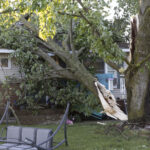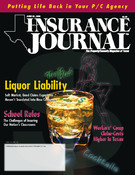In prehistoric times—more specifically the time of the dinosaur—the Texas Coast was somewhere near Glen Rose. At least that’s one of the nuggets of information I’ve hung on to since a trip to Dinosaur Valley State Park last year. It was on a map in the visitor’s center, along with other interesting hidden tidbits, like, for instance, that the Tyrannosaurus Rex was not even around during the Jurassic period. (I didn’t believe Jurassic Park anyway.)
These thoughts crossed my mind as I thumbed through portions of a recent 600+ page report on global warming. The report, a product of the U.S. Global Change Research Program, was authorized by Congress in 1990 to coordinate research among agencies of the federal government and to conduct periodic assessments of the effects of global change on the United States.
Their report, which is currently in draft form and open to the public for input, drew on hundreds of published scientific reports and included the work of hundreds of climate scientists.
Here is the short version of what the report says:
• It will get warmer. Models predict that temperatures will rise 5-10¼F in the next 100 years.
• Changes will vary widely from region to region. While some areas will get drier, they expect more frequent heavy and extreme precipitation events.
• There are several vulnerable ecosystems, including the alpine meadows in the Rocky Mountains and some barrier islands, which could completely disappear. The forests of the Southeast are also expected to change dramatically.
• Concerns about stable water sources will be intense as increasing drought will tax many systems. Snowpack changes are especially important in the West, Pacific Northwest and Alaska.
• There will be increased damage in coastal areas. Global sea level, which has already risen 4 to 8 inches over the past century, will rise another estimated 19 inches over the next century. It’s this last point that I struggle with the most. There are many towns, like Galveston, where a large portion of the town would be affected by over a foot of water. Would South Padre Island disappear? Can you build a seawall strong enough, or haul in enough dirt and sand, to keep out an encroaching sea? Can insurers mitigate the Gulf of Mexico? With over 50 percent of the population living on the coast, and the migration continuing each year, our coastal regions are burgeoning with activity. The wealth of our current economy manifests itself into massive glass buildings, teetering on stilts yards from the ocean.
Two years ago naysayers were saying there was no such thing as global warming. Today, they say, OK, so the earth is in a phase, no big deal. And perhaps it’s not. Maybe the changes happen so slowly and gradually that the entire earth just adapts—acclimates to the changes.
But then again, maybe it’s like gaining weight as you age. Slowly, month by month, you gain an ounce here and an ounce there. Ten years down the road you notice an extra 30 pounds that didn’t use to be there and you want to get rid of it. Talk about a difficult road. I say this because every insurer I’ve asked about global climate changes shrugs his or her shoulders and says “so?Ó I understand their position. How do you plan for something that is out of your control? You really can’t. But there are things insurers can do. When auto safety was a key concern for insurers, they brilliantly created the Insurance Institute for Highway Safety, a public relations machine that has generated international attention.
Auto emissions could be included under this umbrella. They could also become involved in flood plain control, protecting urban areas that have become slabs of concrete just waiting for a persistent rainstorm to flood neighborhoods.
I could go on and on. But my point is quite simple. Global warming, or whatever name you would like to give it, is really happening. It will not change things overnight. And it will affect the insurance industry.
Was this article valuable?
Here are more articles you may enjoy.


 Acrisure CEO Greg Williams Makes $400M Commitment to Michigan State University
Acrisure CEO Greg Williams Makes $400M Commitment to Michigan State University  State Farm Sued Over Policies Backed by Distressed Insurer PHL
State Farm Sued Over Policies Backed by Distressed Insurer PHL  Baldwin Group to Buy CAC Group for About $1B in Cash and Stock
Baldwin Group to Buy CAC Group for About $1B in Cash and Stock  One of Highest Property Claims Severity Recorded in Q3 on Low Volume, Says Verisk
One of Highest Property Claims Severity Recorded in Q3 on Low Volume, Says Verisk 


